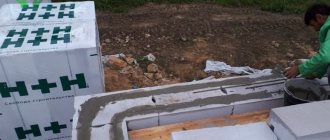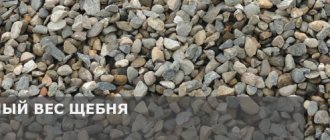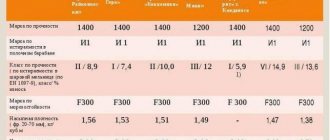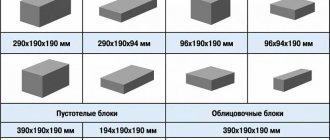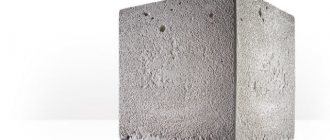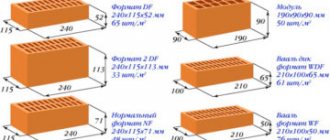The material with the addition of a foaming agent belongs to the category of cellular concrete, therefore it has characteristics suitable for construction. However, the size and weight of the foam blocks are also important, because the type of foundation, as well as the speed of construction of the structure, will depend on these parameters.
How much can a foam block weigh? Let's find out...
Another important advantage is good thermal insulation, which provides an opportunity to reduce the cost of insulating a home.
The photo shows pallets with foam concrete blocks.
Light weight
The lightest building material today is foam block. This quality of material is of great importance in insulation and construction. Relatively quiet thermal conductivity makes it possible to make walls thinner than in construction with other materials.
For example, if we compare a foam block with a brick or cinder block, then for 1 m2 of a brick wall you will need 190 pieces. With a weight of each product of 5 kg, the mass of the wall is 950 kg. To construct the same foam block wall, you will need 21 kg of foam block. The mass of the wall will be 600 kg.
Even with this example, it can be determined that the foam block is much lighter than other materials, and, therefore. when it is necessary to load the structure to a minimum, foam concrete is the most suitable material. The foam concrete product is lightweight and convenient for construction; the excellent processing of this material is the result of its porous structure. This material is processed on the construction site; blocks can even be cut with a simple hacksaw. Almost everyone claims that the mass of the foam block is small, but only a few know exactly what it is, and then, probably, professional builders.
How to determine the weight of a concrete product?
If you need to determine the mass of a foam block, but there is no measuring equipment nearby, then you can use certain actions. The mass of a concrete product depends directly on the density value. It turns out that we find out the density of the material - we calculate its mass. If you do not take into account the moisture content of foam concrete, then the density of this product will be equal to the mass of its cubic meter. The density of a concrete product depends on its composition: cement, water, sand. All these ingredients are contained in 1 m3 of foam block. Let's look at the product labeling. For example, in a foam block product marked D300, it is precisely indicated to us that 1 m3 weighs 300 kg, D500 - 500 kg.
To calculate the weight of concrete, you need to multiply its density by its volume. Let's calculate the weight of a product marked 600x250x100 using an example. First, let's calculate the volume of one product; to do this, convert the dimensions into meters and multiply our values 0.6x 0.25x 0.1. We get the result - 0.015 m³. We determine the weight by multiplying 0.015 * 400. The mass of our material is about 6 kg. This calculation will be correct if the material is dry; it is worth considering that the product can, having absorbed moisture, increase up to 20%. For example, if a dry D600 block weighs 22 kg, then in a wet state the value will increase to 25 kg. If we calculate the most standard option with the marking 600x300x200 using this principle, we will get the mass of one block - 22 kg, 600x250x50 - 4 kg, 600x250x75 - 7kg, 600x400x300 - 28 kg.
This calculation will be useful when the product is non-standard. The mass of models with standard sizes has already been calculated by the manufacturer. For example:
- D400 – material weight 15 kilograms;
- D700 - weight 27 kilograms;
- D1200 – weight 47 kilograms.
You can determine the mass of the product differently, simply by taking into account the mass of a cubic meter of material and the number of foam blocks included in it. Sometimes it is still easier to ask about the mass of the purchased material from the seller or manufacturer, because production is different, the mass may not match, even if everything has been theoretically justified correctly.
Different manufacturers have different weights of blocks, despite the same dimensions.
If we consider the density characteristics, then the blocks can be thermal insulating and structural. Depending on the brand of material, the weight of the product will also change.
For example, if you find out the characteristics of a foam block with the D300 brand, then in the wall version the weight of one block of size 600x300x200 will be close to 11 kg, for a partition block with a size of 100x300x600 - 5 kg.
Technical characteristics have allowed foam concrete to take a leading position among other materials in construction. The foam block construction of the wall allows you to make the temperature in any room comfortable. A house made of a modern concrete product retains heat in the winter, and in the summer it works like an air conditioner, preventing heat from entering the room.
Foam concrete blocks have a high degree of thermal insulation and strength. Depending on the density of the building material, it is used both for the classical construction of houses and for thermal insulation work. Understanding how much a foam block weighs is very important when designing a house, as it allows you to correctly calculate the design weight of the walls and the load they create.
What is foam concrete
This is the name of a porous material that is produced using foaming additives. There are synthetic and organic impurities used to change the properties of the material. Due to this, the weight of foam concrete is reduced. However, the material contains cement.
As a result, fairly durable products are obtained. Moreover, their properties improve with use. Thus, the strength of the foam block after 30-40 years of service increases by 3-4 times. This allows the structure to be used for much longer. When studying the question of what foam concrete is, you should find out what it consists of.
So, the main components are standard: water, sand, cement. When choosing additives, preference should be given to organic materials. They have a protein base, which makes it possible to obtain more durable foam concrete blocks. The cost of such products is much higher than analogues containing synthetic additives.
Cheaper materials have a significant drawback - they belong to hazard class 4. Despite this, the finished foam concrete block cannot cause harm to health. Only the working solution is dangerous. When foam concrete is mixed, the composition changes: additives are added that form foam. At this stage, you should work carefully with the finished mass. As they harden, the toxicity of synthetic additives decreases.
When considering the question of what a foam block is, you need to consider the following: such a product is produced using different technologies, which will determine the quality of the edges, their smoothness, and dimensions. Even large bricks can weigh little.
This parameter is determined by the properties of foam concrete: the finished mass contains air bubbles, resulting in the formation of a porous material. Moreover, the density of the foam block is small. You can increase it using bulk components: clay, ash.
At the same time, the strength of foam concrete increases, since the reliability of the partitions between the pores increases. At the same time, there is a reduction in cement costs, as its consumption is reduced. This composition of foam concrete has disadvantages - the thermal conductivity of the mixture increases, which is due to a decrease in the size of pores filled with air.
This means that if foam blocks are used, the thickness of the object’s wall must be increased. An alternative option is to use thermal insulation.
How to calculate how much a foam block weighs. Calculation method.
To calculate the mass of a foam concrete block, you need to know its volume. To do this, use the formula: Block volume = height x length x width. Hence, the volume of a D400 foam concrete block with dimensions 200x300x600 mm = 0.036 m 3.
The mass of one foam block 200x300x600 mm and density D400 can be calculated using the formula: 〖mass〗_foam block =0.036×400=14.4 kg
Taking into account the humidity (8-15%) that the sand-based material absorbs, you can calculate the weight of one foam block:
- at humidity 8% 14.4×1.08=15.55 kg;
- at humidity 15% 14.4+1.15=16.6 kg
There are three types of foam concrete blocks:
- structural - for the construction of foundations and load-bearing walls. For these purposes, foam blocks of the D1000-D1200 brands are used;
- structural and thermal insulation - for various types of partitions (D600-D900);
- thermal insulation (D300-D500).
Foam concrete blocks are a building material used for the construction of outbuildings, private and low-rise buildings, fences and other structures. The structure of foam concrete is porous and consists of closed cells. That is why it has good thermal insulation characteristics and absorbs less moisture than aerated concrete. Buildings built from foam blocks do not require additional insulation. You can buy foam concrete ready-made or make it yourself.
- long service life;
- does not burn and does not support combustion;
- light weight;
- one block measuring 600x300x200 replaces 15 standard bricks;
- simple way of laying;
- low thermal conductivity coefficient;
- environmentally friendly and safe;
- holds air noise well;
- low cost.
Dimensions and weight
According to their purpose, the blocks are either wall or partition. The weight of foam blocks for walls and partitions differs significantly, since they have different parameters. The standard size is 600x300x200 mm, but there may be other dimensions, for example, 400x200x200 mm. The length of all foam concrete blocks cannot exceed 60 cm. This requirement is established in GOST. Semi-blocks are produced in different sizes - 600x300x100, 600x250x100, 600x250x75 mm and so on.
The weight of one piece of foam concrete is influenced by its size and type. Due to their highest density, structural ones are the heaviest. The weight of the foam block can be 39-47 kg, depending on the manufacturer. One piece of septum weighs on average 21 kg.
Structural thermal insulating foam concrete has less weight, since its density is lower. Standard blocks for walls 200x300x600 mm weigh from 19 to 36 kg, depending on the strength brand, one piece of half-block - 9.5-18 kg.
Thermal insulation has the least strength due to the small amount of cement. Therefore, they have the lowest weight - wall ones from 11.6-19.5 kg, partitions 100x300x600 mm - 5.8-9.7 kg.
Kinds
For the production of foam concrete, cement, sand, water and a foaming component are used. The more binder powder is poured in, the higher the strength will be. But because of this, the heat-retaining characteristics are reduced.
According to density, foam concrete blocks are of the following types:
- structural;
- thermal insulation;
- structural and thermal insulation.
The first type has the greatest strength. Available in brands D1000-D1200. Structural foam blocks are used for the construction of foundations and load-bearing walls. They contain the most cement, therefore they have the lowest thermal conductivity coefficient compared to other types - 0.29-0.38 W/m K.
Thermal insulation blocks, on the contrary, retain heat in the building better than others - 0.09-0.12 W/m·K. But due to the large number of pores, they have low strength, so they can only be used as insulation for an already rebuilt structure. The weight of this type of foam block is significantly less than structural foam concrete. The brands D300-D500 are manufactured.
Structural thermal insulation foam concrete is the most common, as it has equally good insulating and strength characteristics. Used for the construction of load-bearing walls and partitions. Thermal conductivity coefficient is 0.15-0.29 W/m K. Structural and thermal insulating foam blocks come in grades D500-D900.
The blocks also differ in the production method - molded and cut. The first type of foam blocks is made in molds. This is the method you can use to make foam concrete with your own hands. The disadvantage of molded blocks is the risk of obtaining building materials with unequal edges, which complicates the process of laying with the smallest joint thickness.
The best option is cut foam blocks. They are made from one monolithic slab by cutting it into pieces. The result is a building material with identical edges.
Price
Prices for foam blocks depend on their size, type, brand and manufacturer. If additional components were used to make a more durable block, for example, fiberglass, then the price per piece will be higher compared to conventional foam concrete.
| Name | Dimensions, mm | Price per piece, rubles |
| D600 | 100x300x600 | 51 |
| 120x300x600 | 61 | |
| 150x300x600 | 73 | |
| 200x300x600 | 94 | |
| 400x200x600 | 128 | |
| D400 | 600x300x100 | 56 |
| D1000 | 76 | |
| D400 | 600x300x200 | 108 |
| D1000 | 148 | |
| D400 | 600x300x250 | 135 |
| D1000 | 185 | |
| D400 | 600x400x200 | 147 |
| D1000 | 202 | |
| D400 | 500x300x150 | 68 |
| D1000 | 93 |
The type of building foundation depends on how much one standard size foam block weighs. The heavier it is, the deeper and stronger it is necessary to build the foundation so that it does not collapse under the load.
Before purchasing foam concrete, you need to study it for strength, evenness and safety. The first characteristic is checked by cutting one foam block. During sawing, it should not crumble much, as this is a sign of low-quality and fragile building material. Evenness can be checked by stacking several blocks on top of each other. There should be no gaps between the walls.
Environmental safety can be verified only by requesting quality certificates from the seller, which indicate the detailed composition and scope of application. You should not buy foam concrete in unverified places; it is best to purchase directly from factories or their representatives. When calculating the amount of material, you need to add at least 10% in case some of the foam blocks are destroyed during transportation.
Foam blocks of all types are a universal building material. They are widely used in the construction of inexpensive but high-quality buildings, such as a country house.
According to its characteristics, this material belongs to porous concrete and in many respects is considered much better than traditional brick. The standard sizes of foam blocks, their low weight allows the use of a very small team of builders for masonry.
When using foam blocks for the construction of buildings on a summer cottage, due to its size, the construction process will proceed faster
Installation of a prefabricated strip base made of blocks
First, an installation diagram is drawn up, and the following operations are carried out according to it: assembling the cast-offs, knocking out the end walls along the axes using a construction cord, knocking out the longitudinal walls, attaching the mooring cord and marking the main axis of the foundation.
Installation of strip prefabricated block foundation - layer options
In more detail, the construction process looks like this:
- A tight cord or thin steel wire is pulled over the cast-off so that the strip base can be broken down along it;
- A solid block is installed at each corner of the base;
- Departing from them 1.5-2 cm, beacon FBS are installed;
- A cord (wire) is stretched between the corner and lighthouse products, intermediate blocks are installed along it, it is allowed to use hollow products measuring 200x200x400 mm;
- Each block after installation in place must be aligned horizontally and vertically.
For the installation of the zero cycle, the same techniques are used as for assembling any prefabricated base, with one difference - it is allowed to use used FBS products. It is impossible to install large blocks manually; you will have to rent a crane or use a construction winch, but if you use a 400x200x200 mm block to build the foundation of a private house, then you can install the base yourself, which will make the process much cheaper.
Installation of a block foundation using a truck craneEven when renting a truck crane to install the foundation of a private house, the work will be much less, since the size of an industrial and private project is not comparable. Therefore, the extension of the crane boom will be enough to avoid moving from place to place, but to collect the tape from one cleared area on the construction site. But to be on the safe side, the site layout plan must be suitable for the construction of multi-storey and large facilities.
To save budget, the zero level can be achieved using not blocks, but natural stone, lightweight concrete blocks or bricks. cellular concrete. For example, when constructing light buildings such as a wooden garden house, bathhouse, summer kitchen, garage or greenhouse for the zero cycle, you can take foundation blocks measuring 200 x 200 x 400 mm.
From small blocks you can build supports for a columnar foundation for weak, heaving and waterlogged (peaty or swampy) soils. To construct such a structure, the blocks are buried in the ground below its freezing level, and the supports are connected using a reinforced concrete grillage, steel or wooden beams.
Concrete blocks for columnar foundation
Features and advantages of foam blocks
This material is becoming increasingly popular in the construction market. It has its own technical characteristics and special qualities.
The main advantages of foam blocks:
- Reliability
. Foam blocks are not subject to any external influences. They have truly stone strength and can be used for a long time, maintaining the internal structure. - High heat resistance
. This property can significantly reduce heat loss in winter. In summer, in hot weather, the size of the foam block and its structure make it possible not to allow high temperatures to pass through. Thus, an even microclimate is created inside the building and the required level of air humidity is maintained. - Environmental friendliness
. In this parameter, foam blocks are second only to wooden structures. If we take the environmental coefficient of wood as one, then for a foam block it will be 2, for sand-lime brick - 8, for ceramic brick - 10. - Quick installation
. Due to their low density and light weight, foam blocks are laid many times faster compared to the same volume of brickwork. One cube of foam blocks weighs much less than 1 m3 of brick. This process is further simplified, since the dimensions of the foam blocks for building a house are precisely measured. Thus, the speed of masonry work directly affects the total cost of construction and installation work. - Soundproofing
. These products are capable of high-quality sound absorption. According to this parameter, the size of foam blocks for partitions is almost twice as effective as brick or conventional reinforced concrete. - Fire safety
. Foam blocks are non-flammable materials. They reliably localize fires. The tests carried out allowed us to assign this material the first degree of fire resistance.
The process of laying foam blocks is not much different from laying ordinary bricks
Areas of application
Foam blocks are used in the construction of low and medium-rise buildings for various purposes. This material is inferior to concrete in strength; even reinforcement does not help to completely solve this problem. Foam blocks are used in the construction of industrial buildings and private houses. They are used when load-bearing walls and internal partitions are built, as well as for the purpose of thermal insulation of an object.
In each case, different types of products are used: structural (the most durable), structural and thermal insulation, thermal insulation. The first option is characterized by insufficiently low thermal conductivity, which is why the building is additionally insulated. Thermal insulation products, on the contrary, are much less durable compared to structural analogues, but retain heat better.
Structural characteristics of foam blocks
When finished, foam blocks have the appearance of a porous stone, similar to cellular concrete. For the manufacture of products, a special mixture is used, which includes cement, sand, water and pre-prepared foam. All components are thoroughly mixed together mechanically. When solidified, through pores are formed in structures, giving the material all the necessary properties.
By changing the proportions of the components, you can achieve different technical characteristics. For example, by reducing the amount of sand, the strength of the foam block increases. This allows you to create structural elements used for various purposes.
The process of laying foam blocks is faster than laying conventional building bricks when building a house
Main types of foam concrete blocks:
- Structural
. They have the greatest strength and are used for constructing foundations, plinths and laying load-bearing walls. Their main brands are D1000, D1100, D1200. They correspond to strengths of 50, 64 and 90 kg/cm2. The density of such foam blocks ranges from 1000 to 1200 kg/m3. The weight of a foam block of this type is 39-47 kg, a half-block will weigh 19-23 kg. - Structural and thermal insulation
. They have average strength, suitable for laying walls and partitions. These include grades D500, 600, 700, 800 and 900 with corresponding strengths of 13, 16, 24, 27 and 35 kg/cm2. The density indicator for these products is from 500 to 900 kg/m3. Each such foam block has a weight of 1 piece 23-35 kg, and a half-block - 11-17 kg. - Thermal insulation
. Structures with minimal strength are used to create thermal insulation for external walls. They are represented by grades D300, 350 and 400. For the first two grades, the strength is not calculated, but for D400 it is 9 kg/cm2. The average weight of such a block is 11-19 kg, half-block - 6-10 kg.
Non-standard structurally porous foam blocks with increased strength, grades D1300-1600, are produced separately.
Non-standard structurally porous foam blocks attract with their strength
Manufacturing technology of foam concrete blocks
The foam concrete block is produced using one of the following methods:
- Classical. Foam is supplied from the foam generator to the cement mixture, then everything is mixed. A foam concrete block made using this method has the best characteristics;
- Dry mineralization. In this method, foam is added to the dry mixture, and then a small amount of water is added with constant stirring. This results in continuous production of foam blocks;
- Barotechnology. The foaming agent is first mixed with water, and then with other components of the composition. All this happens in a pressure chamber at high pressure.
Weight and dimensions of foam blocks
Depending on the application, all foam concrete structures are divided into wall blocks and semi-blocks. In the first case, the standard size of the foam block is 600x200x300 mm, which corresponds to length, width and height. The other type of product is narrower with a width of 100 mm. In many cases, the size of the foam block is not always standard. At the request of the customer, structures can be manufactured with individual volumetric characteristics.
The weight of each product depends on its density. For example, the weight of a 600x300x200 structural type foam block can range from 39 to 47 kilograms. If we divide each product by brand, then the weight of a 600x300x200 D600 foam block will be 23.3 kg, while a product of a lower brand with the same dimensions will weigh significantly less. For example, the weight of a 600x300x200 D500 foam block is only 19.4 kg.
There are products with non-standard sizes, made using German Hebel technology. They are distinguished by high quality and reliability. The weight of the foam block 600x250x100 is very small, only 10 kg.
These materials are widely used for the construction of partitions. For this purpose, products with their own parameters are produced. A standard partition foam block has dimensions of 600x300x100 mm, and its weight depends on the brand, which reflects the density of a particular element.
Thus, to the customer’s question about what sizes of foam blocks there are, manufacturers answer with the widest range of manufactured products.
Foam blocks are large in size, high quality and very durable
Is it worth purchasing glass blocks?
Interior glass partitions are distinguished not only by style and beauty, but also by the highest level of durability. Today these are the only blocks that, after installation, do not require decorative or other finishing at all. They are beautiful in themselves. The glass block includes 2 glass plates, they are hermetically connected to each other. The surface of the glass can be smooth, have external or internal relief. This allows you to purchase blocks of exactly the variation that is needed. The color of the material can be any. The shape is most often square, but today you can buy glass blocks for partitions of other types.
The peculiarity of using this material is that the interior partitions are translucent, but the possibility of peeking is limited. Among the advantages, it is necessary to note a high level of fire resistance, 100% moisture resistance of the block, and a high level of durability. Such a block is not easy to scratch; they rarely break. Temperature differences allowed when using such units are -50/+200°C.
Connection diagram of glass block sections.
Typically, a block whose dimensions are 80*190*190 mm, 80*240*240 mm can be used for work. The weight can vary from 2.2 kg to 4.2 kg, depending on the shape and size. There are special additional elements in the form of corner and half blocks, the dimensions of which are 80*190*90 mm. The use of such products is convenient for constructing partitions of unusual shapes, when processing corners, etc. Some manufacturers offer shaped products of unusual shapes: triangular, round. Their surface can be smooth or corrugated; the glass surfaces themselves are available matte or transparent. Therefore, it is easy to choose the material that best suits your needs.
The shape of the partition can be a standard straight one, but curved options are also used, which give the interior modernity and originality. Today, glass blocks are used for bathrooms, providing protection from prying eyes, allowing free penetration of light. By combining glass blocks, you can achieve an interesting and unusual play of light.
How are glass blocks laid?
The order of work will be as follows:
For laying glass blocks, special masonry mortars are used, which do not contain large particles of sand, so as not to damage the surface of the product and make it less attractive. The material must be installed using a special tile adhesive, which has the necessary adhesion and ensures the highest strength. Suitable adhesive for ceramic, porcelain stoneware, natural stone tiles
It is important to be extremely careful: all adhesive that gets onto the glass surface during work must be removed immediately after application, before it has time to set. The peculiarity of working with glass blocks for partitions is that the glue hardens slowly. It is necessary to carry out the work slowly, taking breaks so that the glue has the opportunity to set securely
In this case, even a high interior partition will be strong and durable. If this condition is not observed, then the wall may simply “float”, and this is fraught with its destruction. For seams, you need to use special liners that make the masonry more reliable. Usually these are metal rods that fit into the grooves of the blocks. After working with the blocks, you can start grouting the joints. For this purpose, use any colored grout that can be used for laying ceramic tiles. Experts advise purchasing grout of a different shade, in which case you get an unusual and attractive effect.
Interior partitions can be made from various materials. They use not only standard foam blocks and bricks, but beautiful and high-quality glass blocks. In any case, you must immediately take into account the characteristics of the material used and the installation technology. For example, the mortar for brick and foam block or gypsum material will be very different, as will the rules for installing the partition itself.
Source
Selection of quality materials
In many cases, you have to choose building materials yourself. When choosing foam blocks, you need to be especially careful, since the quality of the future masonry completely depends on this.
What to pay special attention to:
- All dimensions of structures must be the same. To check this, you need a flat surface on which several blocks are laid closely. Laying should be done alternately, on different ribs. High-quality products always have a tight fit, and there are absolutely no gaps. Particular attention should be paid to the dimensions of foam blocks for partitions.
- The material should not break. This can be tested by rubbing a small piece of block between your fingers. If it crumbles, it means that the manufacturing technology was violated. Visible cracks indicate improper drying and internal stress. Such defects can subsequently cause structural failure. The structure of the material in all parts of the block must be uniform.
- The maximum bubble size is 1 mm. They have a round shape and are evenly distributed over the entire surface. The oval shape of the bubbles indicates the low strength of the blocks.
Many people believe that gas silicate blocks are very light, but this is not entirely true. 1 cube of such material really doesn’t weigh that much, but one block has quite a decent weight due to its size.
Parameters of gas blocks
To find out how many pieces of aerated concrete are in 1m3, you need to accurately navigate the range of similar wall products. According to GOST 31360-2007 “Non-reinforced wall products made of autoclaved cellular concrete”, such building elements are produced in two types - these are blocks and slabs with the maximum permissible dimensions indicated in the table below.
| Size name | Dimensions, mm | |
| Block | Plate | |
| Length | 625 | 1500 |
| Width | 500 | 1000 |
| Height | 500 | — |
| Thickness | — | 600 |
According to this regulatory document, the production of not only solid products is allowed. They may contain voids and technical holes, the parameters of which must meet the requirements of this standard.
Blocks can also be produced with locking elements of various modifications. The latter ensure a more reliable fit of the blocks in the masonry. However, the price of products does not depend on this parameter.
But these are not all the standard sizes that are present on the wall materials market today. The standard also allows for the production of gas blocks of other parameters at the request of customers, in principle, which manufacturers successfully use.
The tables below show the most common sizes of wall blocks. They allow you to use products of light weight, sufficient for comfortable reproduction of masonry with your own hands, while saving mortar due to their volume, and are also mobile enough for transportation both in pallets and individually in the trunk.
Summarizing
- If you have chosen foam blocks as a building material for your home, then even before selecting and constructing the foundation you need to decide on the size and weight of the foam blocks for the external and internal walls. The larger the size and the higher the density, the heavier the blocks and the higher their cost. Accordingly, a more powerful and expensive foundation is required.
- Foam blocks with a density of at least 600 units are suitable for external walls. The most common material is with a density of 900.
- For internal walls and partitions, materials with a density of 100-300 are used. Usually these are blocks measuring 10*30*60 cm.
- Blocks with a density of less than 600 are used only for the heating circuit of the house. They cannot be used as carriers.
- Frost resistance also plays a role. It is necessary to take into account the climatic features of the place of life when purchasing blocks. The house should be warm and comfortable in any weather and temperature.
Thermal conductivity and frost resistance of various brands of foam blocks Source kladka-info.ru
- Check the quality of foam concrete, its color, structure. Request a quality certificate from the seller, which indicates the results of the laboratory test.
- Buy from large sellers of building materials. Reputation is very important for them and it is almost impossible to “run into” counterfeit goods here. If there are only small manufacturers nearby, then all the nuances must be checked especially carefully.
- Price also plays a role in the choice. A price that is too high or too low should be a deterrent. Too low indicates low quality components or cheap technology. Poorly mixed foam concrete will disrupt the bubble structure, the pores will be interconnected, which means the hardness of the material will be impaired and moisture absorption will increase.
Influencing factors
The weight of gas silicate blocks is a variable quantity, depending not only on the dimensions of the product, as is often (and erroneously) thought. First of all, the density of the solid part of the product is of great importance.
The moisture content of the gas silicate will also have to be taken into account. The density level is indicated in the labeling of the supplied product
It is usually measured in kg per m3.
Density grades are designated as DXXX, where XXX is the desired value. There is nothing complicated here; the specific gravity of mass-produced blocks can be 300 or 400 kg. For denser products this figure reaches 500 or even 600 kg. The effect of humidity is also predictable - the more water a sample absorbs, the heavier it becomes, and the porosity of the building blocks only increases the severity of this process.
Moisture saturation is associated with the peculiarities of production technology. Aerated concrete produced in autoclaves inevitably absorbs water. After all, it is always kept in saturated steam, and even under significant pressure. Therefore, at the time of packaging and sending to the manufacturer, the silicate block contains at least 25% water, and sometimes this figure reaches 30%. Accordingly, the release weight also exceeds that declared by the manufacturer.
What is the standard?
The mass of manufactured products is regulated by the standard, provided by production technology and indicated in the product passport. It also records the thermal conductivity, frost resistance and production method and the conditions for optimal use of the block for specific construction projects.
The weight of the blocks depends on the types of filler, their percentage composition, production methods, its strict adherence and must correspond to the indicator declared by the manufacturer. It is taken into account when developing a construction project for a facility and when calculating vehicles.
Consequences of incorrect calculation
the structure may begin to collapse
When the building material puts strong pressure on the foundation, it subsides. This is especially true for columnar foundations, which are installed on floating soil or in areas with differences.
Since industrial buildings are often built from sandwich panels, the load on their foundation is enormous. In addition to the weight of the equipment and people who are there every day, it is worth taking into account the weight of the sandwich panels themselves.
An incorrectly calculated mass of a wall slab will result in the building being in a state of disrepair. Along with the subsidence of the panels, the height of the building may decrease, since the roof also exerts good pressure.
If you take too light panels and build a massive foundation for them, without first taking into account the calculations, then there may be losses in financial costs, since light panels do not require the construction of a massive foundation


